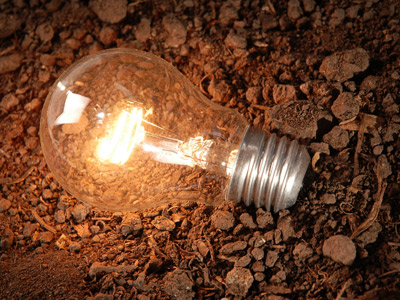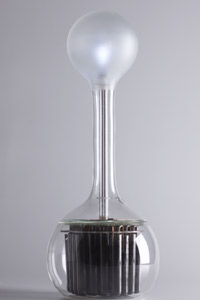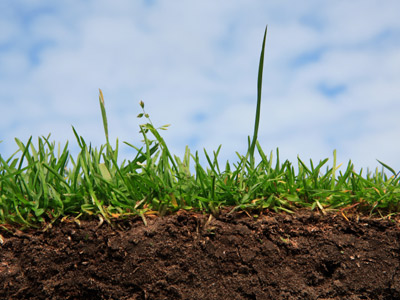How Soil Lamps Work
by Julia Layton
Updated November 12, 2021.
|
The information herein adds credibility to the theory that electricity in the form of "free energy" is available on planet earth. |
The soil lamp relies on those same principles that make a potato or lemon clock work.

As far as traditional electrical lighting goes, there's not a whole lot of variety in power supply: It comes from the grid. When you flip a switch to turn on your bedroom light, electrons start moving from the wall outlet into the conductive metal components of the lamp. Electrons flow through those components to complete a circuit, causing a bulb to light up (for complete details, see How Light Bulbs Work).
Alternative power sources are on the rise, though, and lighting is no exception. You'll find wind-powered lamps, like the streetlamp from Dutch design company Demakersvan, which has a sailcloth turbine that generates electricity in windy conditions. The Woods Solar Powered EZ-Tent uses roof-mounted solar panels to power strings of LEDs inside the tent when the sun goes down. Philips combines the two power sources in its prototype Light Blossom streetlamp, which gets electricity from solar panels when it's sunny and from a top-mounted wind turbine when it's not. And let's not forget the oldest power source of all: human labor. Devices like the Dynamo kinetic flashlight generate light when the user pumps a lever.
Most of us are familiar with wind, solar and kinetic power and what they can do. But a device on display at last year's Milan Design Week has drawn attention to an energy source we don't often hear about: dirt.
In this article, we'll find out how a soil lamp works and explore its applications. It's actually a pretty well-known way to generate electricity, having been first demonstrated in 1841. Today, there are at least two ways to create electricity using soil: In one, the soil basically acts as a medium for electron flow; in the other, the soil is actually creating the electrons.
Let's start with the Soil Lamp displayed in Milan. The device uses dirt as part of the process you'd find at work in a regular old battery.
Earth-battery Lamp

Dutch product designer Marieke Staps created the so-called Soil Lamp. And while the design itself is new, it incorporates a rather old concept, sometimes referred to as an "Earth battery."
In 1841, inventor Alexander Bain demonstrated the ability of plain old dirt to generate electricity. He placed two pieces of metal in the ground -- one copper, one zinc -- about 3.2 feet (1 meter) apart, with a wire circuit connecting them. The result was electricity, about 1 volt's worth -- enough to power the clock he hooked up to the circuit.
This dirt setup is similar to the common Daniell-cell battery, which dates back to the 1830s. The Daniell cell has two parts: copper (the cathode) suspended in copper-sulfate solution, and zinc (the anode) suspended in zinc sulfate solution. These solutions are electrolytes -- liquids with ions in them. Electrolytes facilitate the exchange of electrons between the zinc and copper, generating and then channeling an electrical current. An Earth battery -- and a potato battery or a lemon battery, for that matter -- is essentially doing the same thing as a Daniell cell, albeit less efficiently. Instead of using zinc and copper sulfates as electrolytes, the Earth battery uses dirt.
When you place a copper electrode and a zinc electrode in a container of mud (it has to be wet), the two metals start reacting, because zinc tends to lose electrons more easily then copper and because dirt contains ions. Wetting the dirt turns it into a true electrolyte "solution." So the electrodes start exchanging electrons, just like in a standard battery.
If the electrodes were touching, they would just create a lot of heat while they react. But since they're separated by soil, the free electrons, in order to move between the unequally charged metals, have to travel across the wire that connects the two metals. Connect an LED to that completed circuit, and you've got yourself a Soil Lamp.
The process won't continue forever -- eventually the soil will break down because the dirt becomes depleted of its electrolyte qualities. Replacing the soil would restart the process, though.
Staps' Soil Lamp is a design concept -- it isn't on the market (although you could probably create your own -- just replace "potato" with "container of mud" in a potato-lamp experiment).
A much newer approach to the Earth battery uses soil as a more active player in producing electricity. In the case of the microbial fuel cell, it's what's in the dirt that counts.
Microbial-battery Lamp
It only takes a small amount of power to run a light or charge a cell phone.
If you have a compost pile in your yard, you already know that dirt is an active substance. Or rather, it contains a lot of activity -- living microbes in soil are constantly metabolizing our waste into useful products. In a compost pile, that product is fertilizer. But there are microbes that produce something even more powerful: electron flow.
Bacteria species like Shewanella oneidensis, Rhodoferax ferrireducens, and Geobacter sulfurreducens, found naturally in soil, not only produce electrons in the process of breaking down their food (our waste), but can also transfer those electrons from one location to another.
A startup company, called Lebone Solutions, has come up with a way to harness this microbial electricity to provide lighting and cell-phone charging in rural Africa.
Microbial batteries, or microbial fuel cells, have been around in research labs for some time, but their power output is so low they've mostly been seen as something to explore for some future use. They couldn't power a clothes dryer by any means. But Lebone Solutions has found a use for the microbial batteries: It only takes a small amount of power to run a light or charge a cell phone.
The device is simple to create. It consists primarily of a graphite cloth (the anode) placed in the bottom of a container, covered with soil and a length of chicken wire (the cathode). A conductive wire connects the anode and the cathode to create a circuit, with an LED connected to the circuit.
As the microbes eat the waste in the soil, they produce electrons. Those electrons want to flow toward a more positive charge, so they travel through the bacteria network, moving from the graphite-cloth anode through the conductive wire to get to the chicken-wire cathode. As this current flows through the circuit, an LED lights up.
Lebone estimates that a fuel cell measuring 10.7 square feet (1 square meter) would produce 1 volt, which could charge a cell phone; 53.8 (5 square meters) could power a lamp or a fan Article by Grifantini is no longer active..
In the developed world, a microbial fuel cell would not be an efficient power source. But in rural Africa, where there's no grid power source, this type of setup could be a welcome change from walking several miles to charge a phone. Lebone is currently introducing the fuel cell in several African villages.
References:
Layton Julia, "How Soil Lamps Work," How Stuff Works, Layton: soil electricity
Morelli Francesco Castiglione and Tommaso Ceschi, "Timeless Garden concept draws electricity from wet mud," Perfect Cube, March 3, 2009 Morelli: electricity from mud
Article Sources:
- Alviani, Carl. "The amazing dirt-powered lamp." Core77. Alviani Dirt power laamp
- "How to Make a Potato Battery." Kidzworld. Potato battery
- Grifantini, Kristina. " Microbes for Off-the-Grid Electricity." MIT Technology Review. Sept. 4, 2008. Article by Grifantini is no longer active.
- Singer, Emily. "Better Fuel Cells Using Bacteria." MIT Technology Review. May 23, 2006. Article by Singer is no longer active.
- "Soil Lamp: Mud-Powered LED Light Only Needs Water." Mark's Technology News. Nov. 14, 2008. Soil lamp